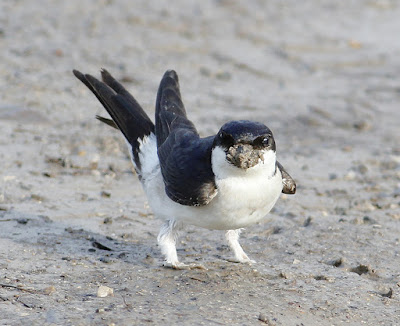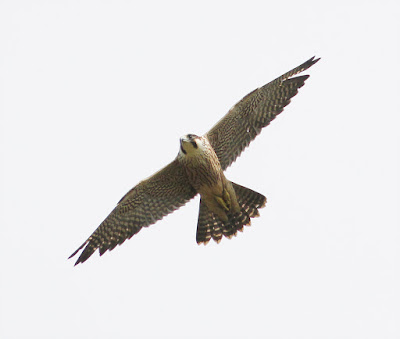There was excitement at Conder Green at the weekend when ringer and birder Ian Hartley, found a North American Lesser Yellowlegs feeding in the tidal creeks. Nice one Ian.
These same creeks are home to many common migrating waders at this time of year (see recent posts on Another Bird Blog), but just occasionally a vagrant and therefore rarer wader appears. It’s a good few years since I put my name to both White-rumped Sandpiper and Pectoral Sandpiper here so it is very enjoyable to connect again with another North American wader on a local patch.
I wasn’t able to get to Conder until today but worked on the assumption that the bird had probably crossed the Atlantic ocean very recently so wouldn’t be inclined to go anywhere else for a while, and would at least feed up for a day or two.
Lesser Yellowlegs - picture courtesy of USFWS
I hear that many folk twitched the yellowlegs on Sunday although not everyone had luck when their target disappeared for a while. Today a dozen or so people were pulled up at the roadside viewing the “legs”, a slimmed down, daintier but long-legged version of our own common and widespread Redshank. Usefully, and for comparison purposes at one point, the yellowlegs fed in the loose company of 3 Ruff, a Common Sandpiper, a Greenshank and Redshanks. It was noticeable that in the pecking order of the creek the yellowlegs was equal to Common Sandpiper, Ruff and the larger Greenshank but Redshanks were able to bully the stranger away when their feeding desires clashed.
This now lost bird may soon get the urge to continue south, but equally and on past occasions, Lesser Yellowlegs have been known to winter in Britain.
The following is by courtesy of Birds of North America Cornell University - http://bna.birds.cornell.edu/bna.
“Lesser Yellowlegs usually travel in small, loosely structured flocks, but concentrations of thousands are seen at preferred foraging sites during migration and at their main wintering areas in Suriname. The species is a widespread migrant in North America, with primary movement through the interior (spring and fall) and along the Atlantic Coast (fall). Across their wintering range and in the southern portion of their breeding range, Lesser Yellowlegs are often found in the company of their larger congener, the Greater Yellowlegs.”
Of the two species the Lesser Yellowlegs turns up more often in the UK than its larger cousin the Greater Yellowlegs, mostly in the autumn but occasionally in spring.
Range of Lesser Yellowlegs in North America
The following disturbing information is also from Cornell University.
“Lesser Yellowlegs were avidly sought by sport and market hunters in the late 1800s. High harvest levels during this period were partly due to this species’ propensity to return and hover above wounded flockmates, making them easy targets for gunners. Many observers of the day speculated that populations declined during this period but subsequently recovered once hunting in the USA was outlawed. As recently as 1991, however, several thousand Lesser Yellowlegs were still being shot annually for sport in the Caribbean, and this shooting continues. Recent (2012) estimates suggest that 7,000-15,000 individuals may be shot each fall in migration at wetlands constructed by shooting clubs on Barbados; perhaps half that many may be shot each fall on Guadeloupe and Martinique, with a potentially significant take also on wintering grounds in Suriname and Guyana. See details in Clay et al. (2012). Clearly this is a significant threat to the species and requires continued monitoring.”
There was sun above so I decided to motor back to Fluke Hall for a walk around. There was a Grey Heron fishing in the wood where it seemed to find what it was looking for. Above the wood - 3 Buzzards, a pair and a flying juvenile.
Grey Heron
Grey Heron
Buzzard
Along the sea wall was quiet except for the usual handful of Little Egrets and Linnets but noticeable numbers of Swallows heading west along the marsh. A Kingfisher flew along the same ditch where I’d seen 3 Green Sandpipers at the weekend, but no sign of the waders today.
Kingfisher
The guy from Hi-Fly said he’d seen the Kingfisher too and recounted again the story of last winter’s Grey Phalarope so I made sure he had my mobile number.
He was busy filling feed bins for the already released Red-legged Partridges. Gangs of the little game birds had legged it across the fields as I approached (they don’t fly much) and I knew that pretty soon birders would be reporting high numbers of the loathsome creatures.
Red-legged Partridge
There are more birds soon on Another Bird Blog - a few flying, one or two just sitting around, maybe one or two feeding but some just legging it.
Linking today to Stewart's World Bird Wednesday.
Linking today to Stewart's World Bird Wednesday.























































.jpeg)










.jpg)












